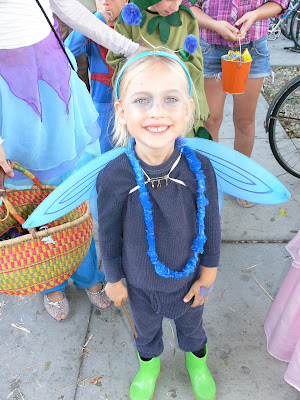
�We boiled the sea water to make salt�. So says Sinead Ni Ghairbhith, organiser of the second annual Clare Harvest Banquet.
That's when I knew that this was in fact the most local local food event I'd ever been to.
The Banquet is a fundraiser for a street children's charity in Mongolia, Astral. Almost 300 are in attendance, and the mood is mighty, with a host of local performers complementing the food.
(pic: a chef, a farmer and a consumer at a Dungarvan farmers' market: says it all really. Copyright Oliver Moore)
Ireland's only Tibetan Lama and even Duncan Stewart himself are here: the latter is making a programme about food and the environment, the former a friend of Ni Ghairbhith.
Indeed the Tibetan and Mongolian dimensions really reveal how positively 'glocal' the whole show is: a local event aware of the globe in all its positive and negative nuances.
The event also acts as something of an agri-food experiment. The aim is to have a completely local event, where all, literally all, the ingredients come from the county of Clare.
Its as if Clare is a blockaded island during a war. Unlike frugal but clever wartime rationing, like boiling the egg in your kettle on the range while making a cup of tea, the aim is to actually have a brilliant banquet. So this is a glorious, spectacular celebration of the resourcefulness and ingenuity and, most of all, of the food of the county.
Even all the unusual frilly extras are local. Like the six local fruits, including pears and grapes. Or the chilli, corriander, and corn on the cob, from the farmers' markets' of Clare.
Local organic fruit and veg growers and suppliers Goerg and Angelika Schleiser produce what is amongst the best veg in the country: up there with Cork's Ultan Quinn. At home, both my nine year old son and my 60+ father can spot their carrots a mile off by their taste and appearance respectively.
Ann Nolan and Clare Linanne from Burren vegetables are also providing great vegetables, as well as oats.
Eva Hegarthy from Kilfinora, who sells at Kilaloe and Ennis farmers' markets, has provided the smoked pork belly.
Clare is especially lucky to have Killaloe's Wines of the Glen, who's gooseberry, elderflower and apple and elderberry wines are a perfect replacement for imported grape based wines. The elderberry is remarkably like a Beaujolais.
Excellent cheeses abound: They include Sinead's sister Siobhan's St.Tolas raw organic goat's cheese, from Inagh. Michael and Lucy Hayes's Mount Callan is another raw milk's cheese featured, this time from a herd of Montbelliard cows.
The Ice Cream, in one of the largest ice cream bowls I've ever seen, comes from Bridget and Rodger Fahy's Linalla in the Burren. Their herd of shorthorn cattle provide exceptional and creamy milk: when its this good, I always go for the vanilla.
A key trick seems to be smoking and storage. Smoking and proper storage means many foods, from fish to apples to spuds, can be eaten out of season in Ireland.
Peter and Brigitta Curtin's Burrensmokehouse in Listoonvarna is renowned for the quality of their salmon and mackrel, smoked in their 5.5 tonne cavernous steel smokehouse beneath their eatery.
Ni Ghairbhith also pointed out that the Irish Seed Savers gave both great apples and great advice on storage. �They have the largest collection of self-rooting apple trees in the world� she tells me. They also have 140 different types of Irish native varieties, making it a great place to source a tree or two.
How did it all taste? In a word, spectacular. Much of the produce was either donated or cost price, and the good vibes must have entered the food by osmosis.
While the effort gone to was a special effort for a special occasion, this event nonetheless acts like a microcosm of what could be done to relocalise food in Ireland. Or, at least, what could be done if Ireland 'the food island' is to reduce food imports. Each year we export nearly E9 billion, but import E6 billion.
The dairy sector, incredibly, is actually an area with serious import substitution potential. We import about E900 million of dairy products into Ireland each year. For every four euros of diary exports Ireland makes, it imports one euro back in.
While for a tiny minority of these imports, a case can probably be made - for example with unusual artisan cheeses - in the majority of cases with dairy one commodity replaces another.
So, while being almost 1000% self sufficient in a commodity like butter, we also import butter. This food product literally passes itself on shipping lanes, coming in and coming out, like shift workers duplicating work.
There are some mitigating circumstances: some of these imports are for the agri-food processing sector, or of products not available or producible here.
However, consumers have a responsibility too: the consumer can and regularly does change consumption patters over time.
For example, there is a growing market for 100% grass fed beef. This would reduce our cereal imports, as well as the carbon footprint of our meat and dairy sectors.
The desire is there: According to Bord Bia research, seven out of ten shoppers want to buy local � and that research was conducted before the recession, when the national economic benefits have become all the clearer in supporting local and Irish. Even then, 93% of those that buy local do so because they want to support the local economy. 58% of supermarket consumers buy local food there.
Growth rates for farmers' markets continue to rise; there are over 150 listed by Bord Bia now. Certainly, while smaller rural markets may occasionally struggle, markets serving a bigger catchment area are thriving.
When I spoke to the department of Agriculture Fisheries and Food about imports and self sufficiency, they informed me that �there would be capacity for import substitution in areas such as pigmeat, poultry, certain dairy products, certain cereals, vegetables and potatoes�.
Not before time, the agri-food sector in Ireland has begun to get its act together to promote Irish food, with the 'Love Irish Food' campaign. Agri-Aware has also gotten in on the act, recruiting high profile economist Jim Power and pointing out that one in seven jobs in Ireland depend on the agri-food sector. Crucially, agri-food has proven itself to be less prone to the recession than other sectors in the economy.










































































